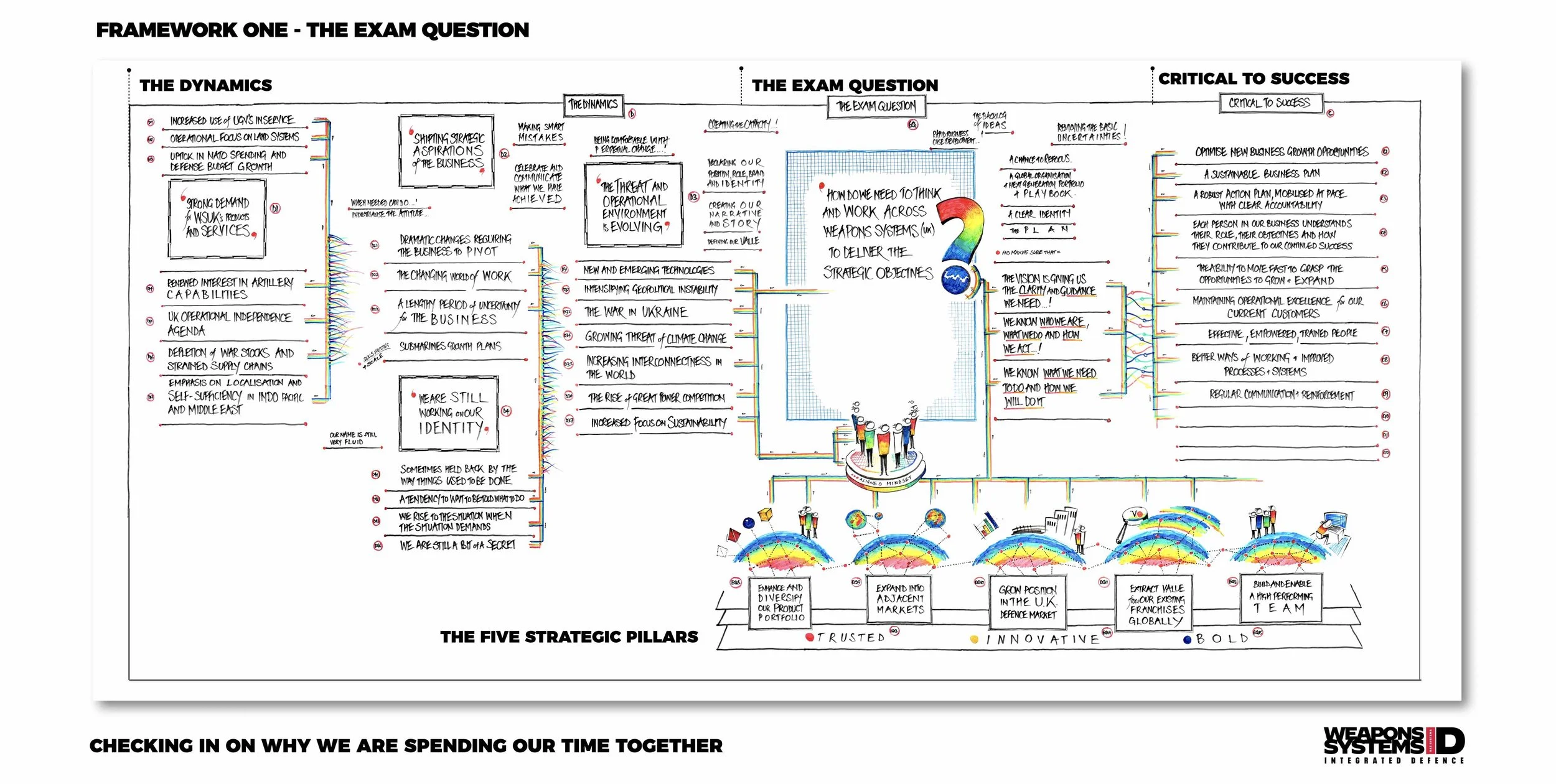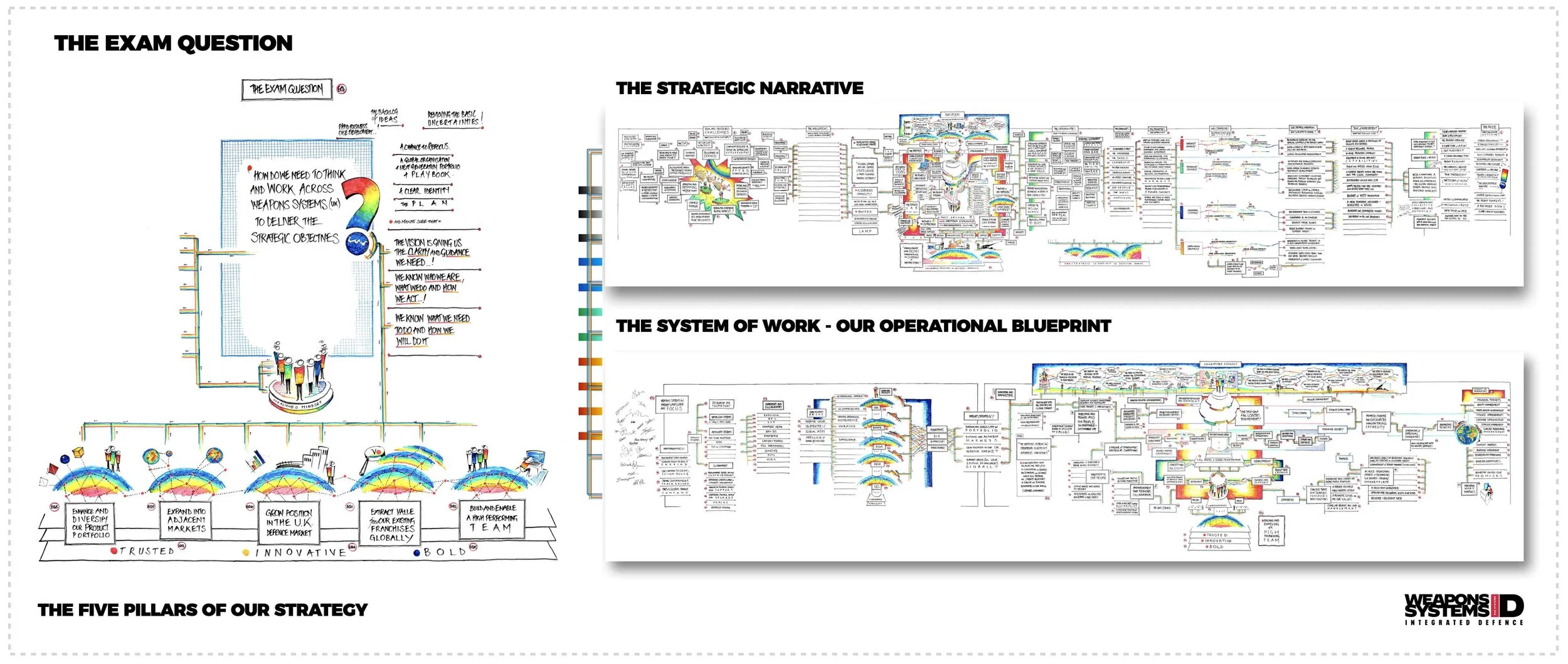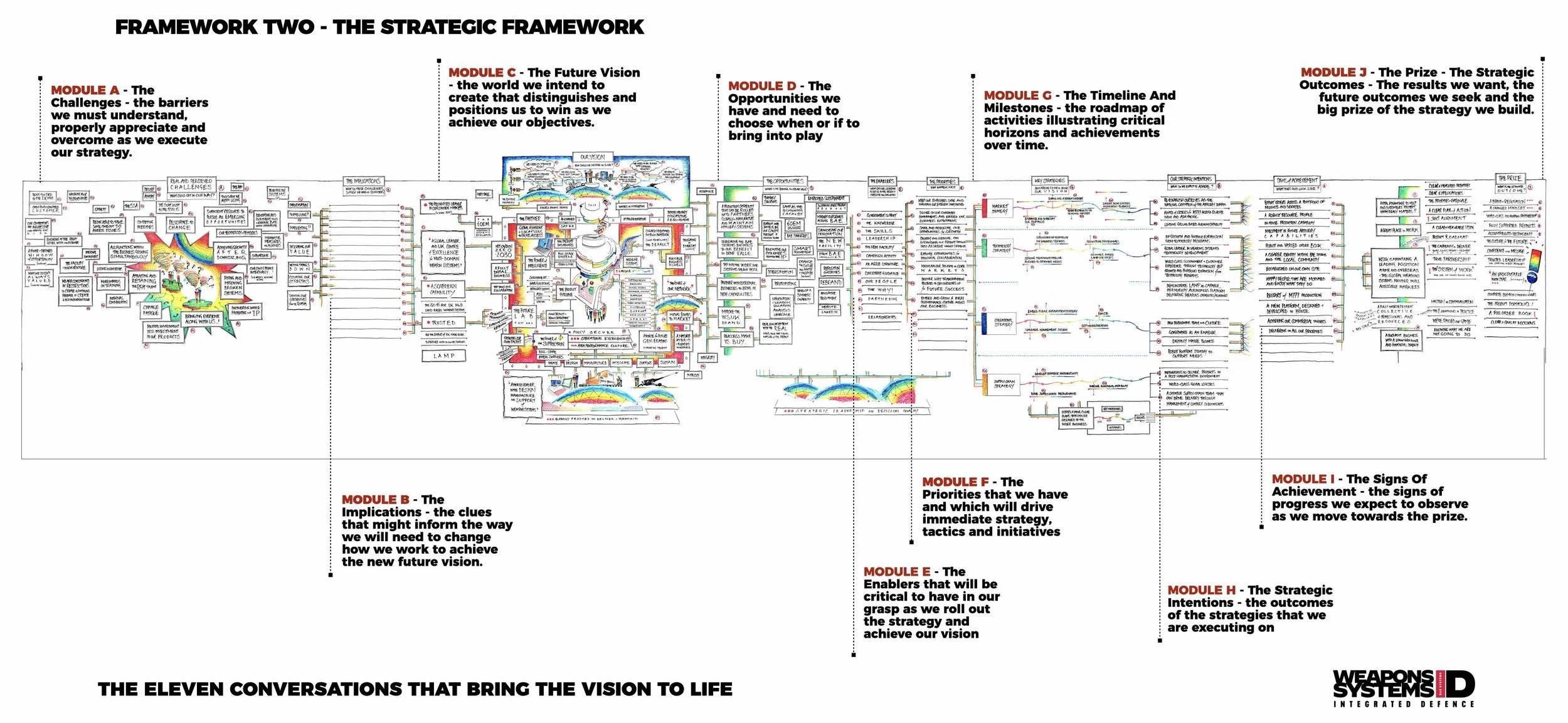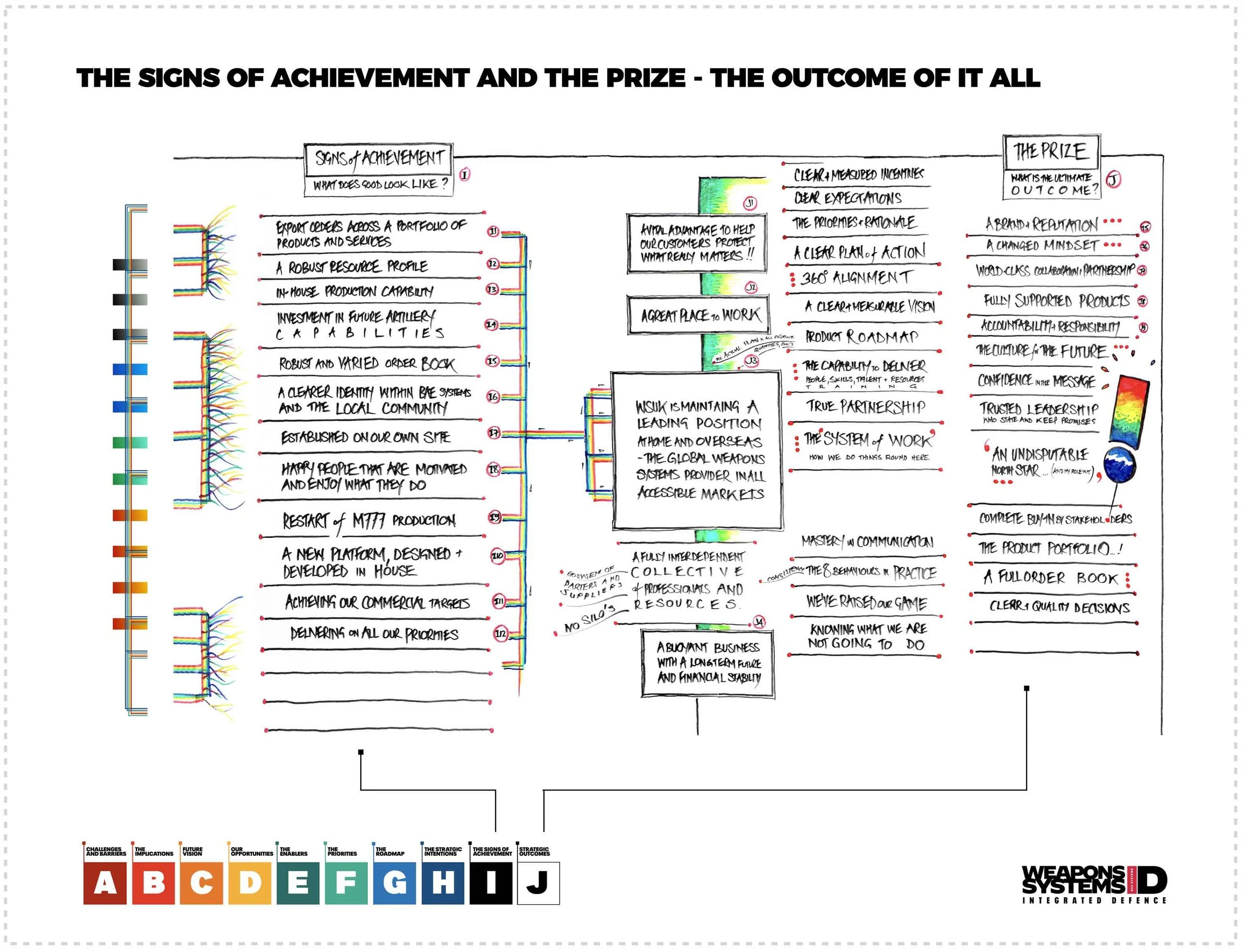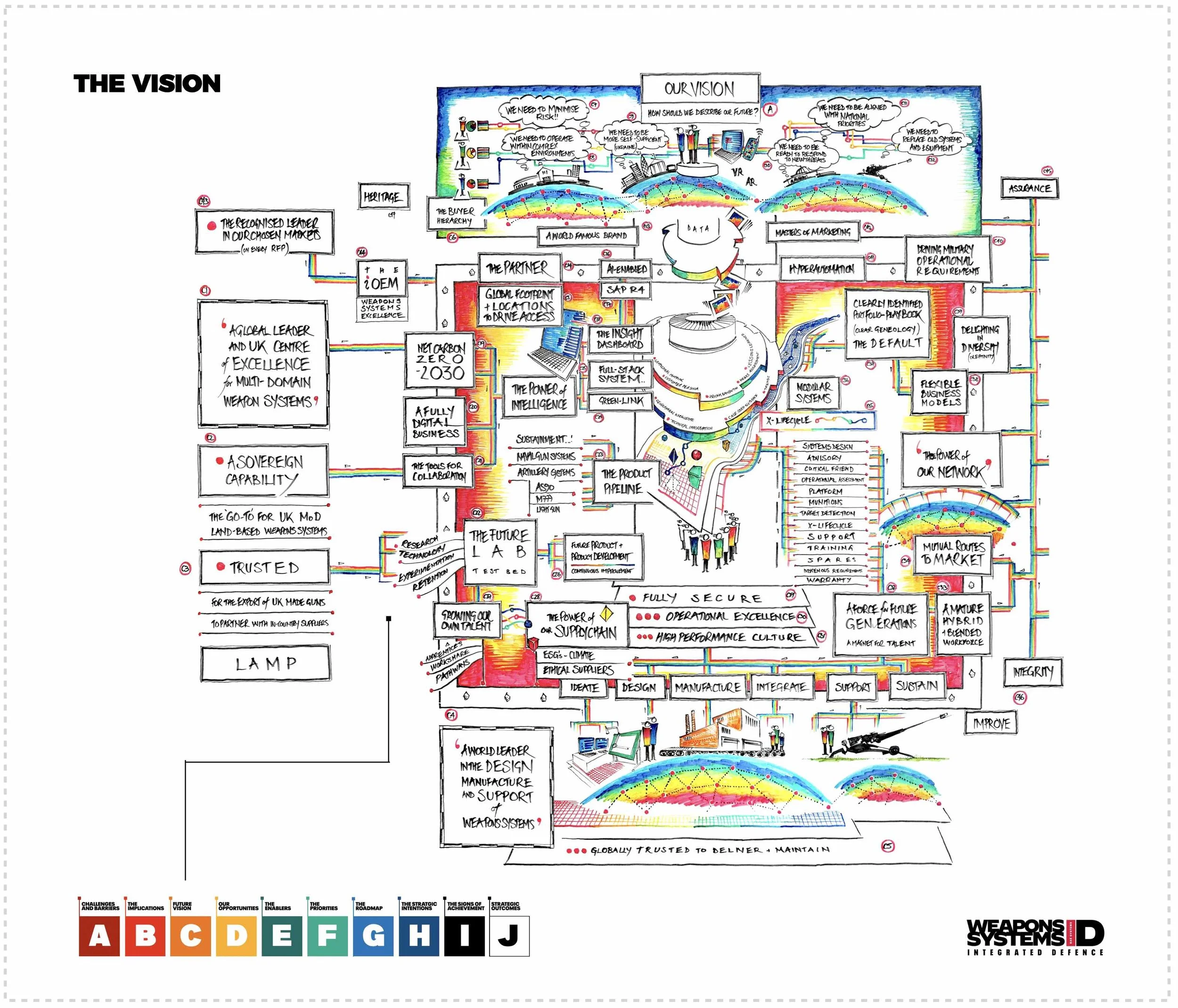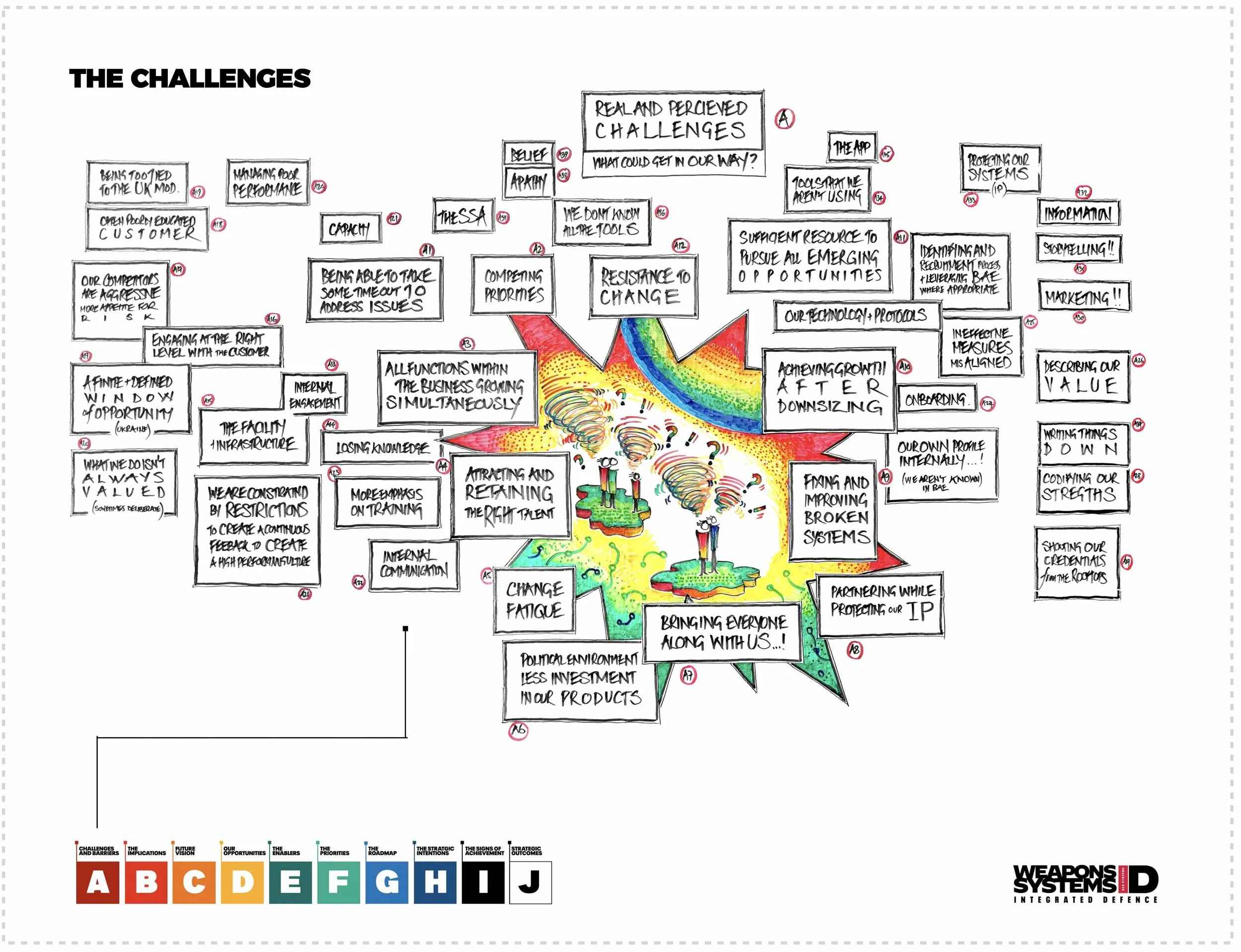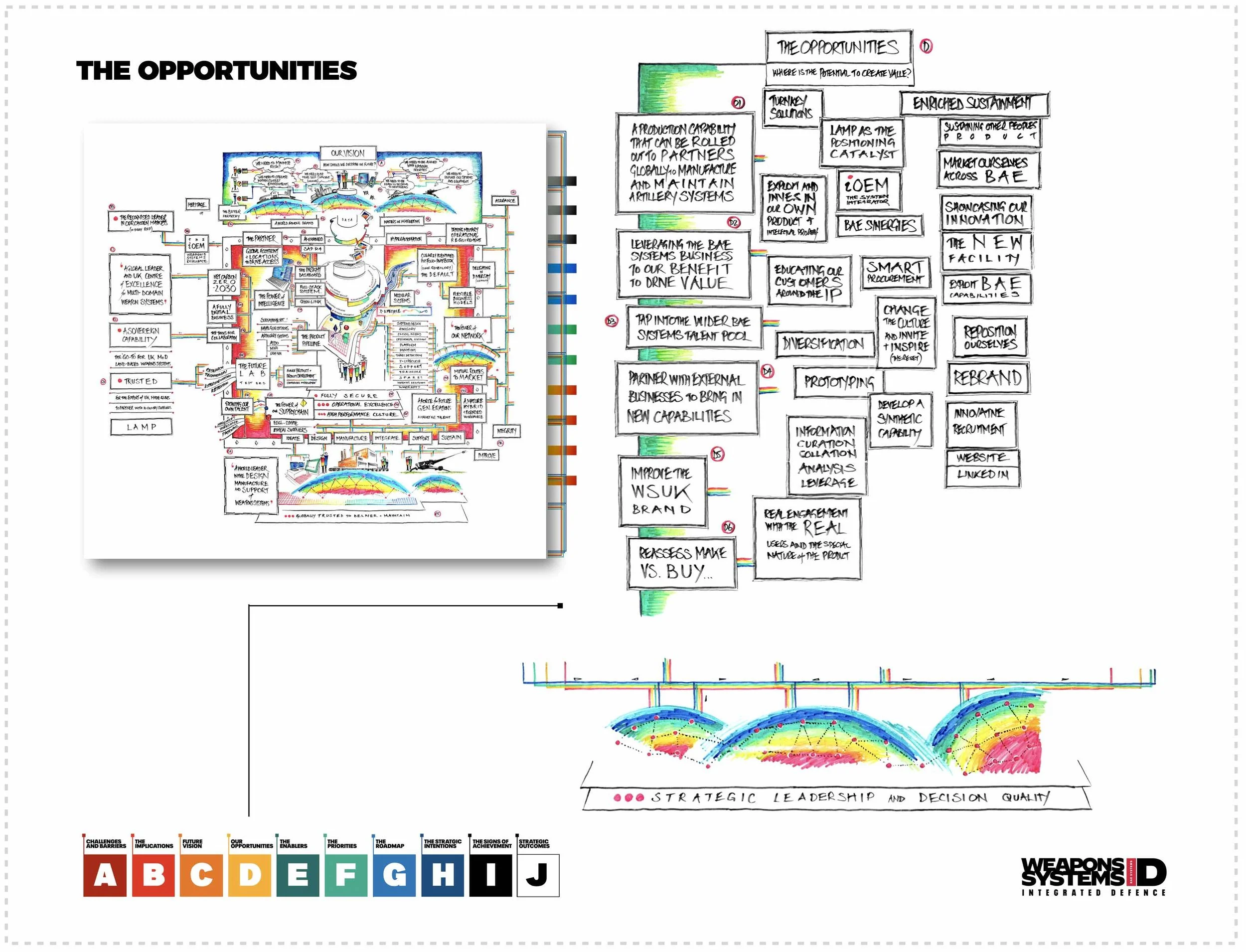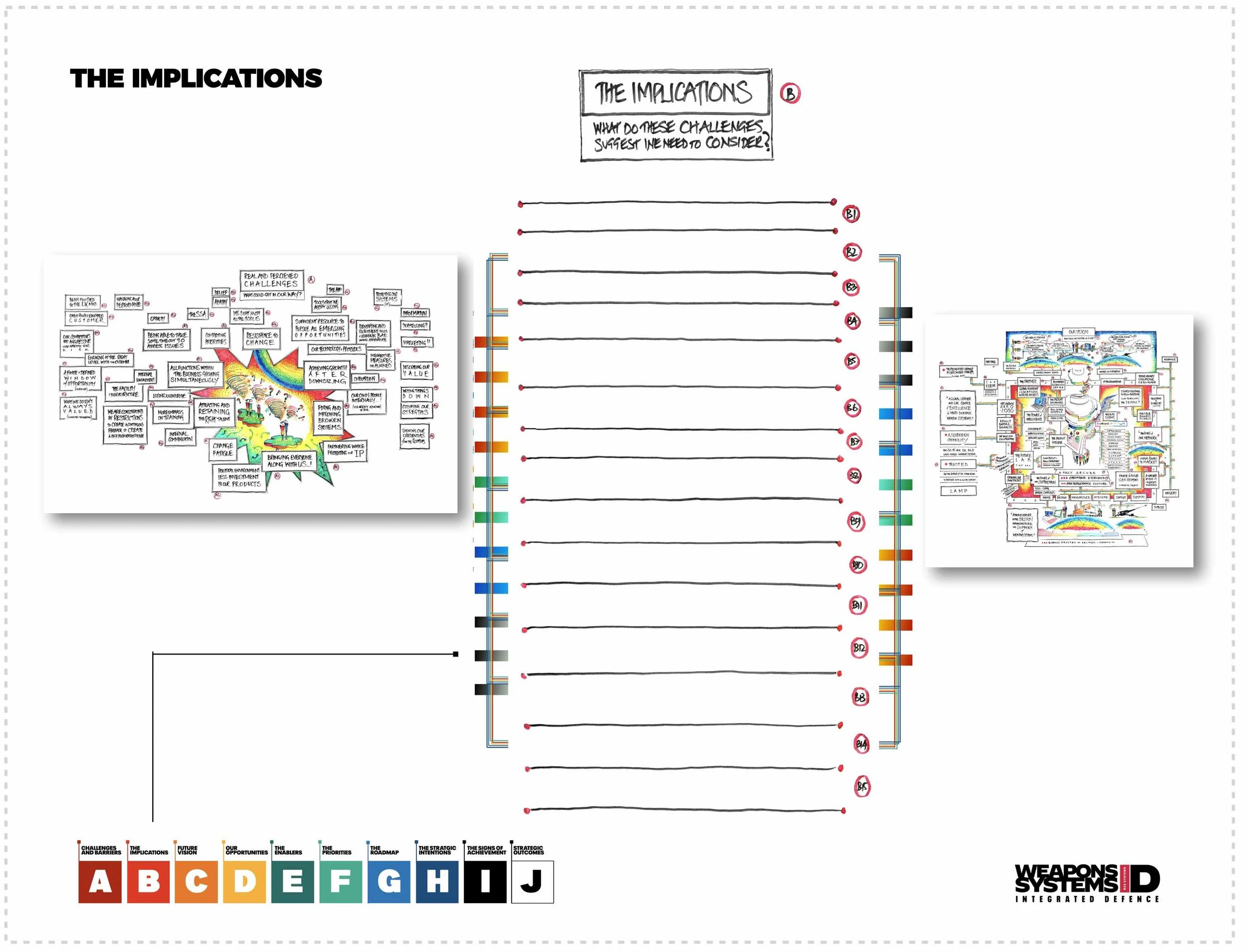
Day One
The day began with some introductions, context setting and objectives.
Why are we here?
Over two years ago, we announced the end of manufacturing in Barrow, which affected us deeply. Since then, a lot has changed - the Ukraine war being a key dynamic with ripple effects.
These changes have resulted in us revisiting our strategy - the goal for today is for us as leaders to bring our experience and perspective into answering the ‘how’ for that strategy, building something that we can use to engage the rest of the business.
Two objectives were clear coming into this:
Engagement as individuals and a collective, ready to take this work back to the business so we can take it forward and include everyone in the enterprise.
Bring our ideas and perspectives to this discussion - there is more we can imagine that will help us strengthen our strategy and bring it to life.
EQ - Starting with the Exam Question
The Exam Question
“How do we need to think and work across Weapons Systems UK to deliver the strategic objectives?”
Making sure that:
The vision is giving us the clarity and guidance we need
We know who we are, what we do and how we act
We know what we need to do and how we will do it
A 10% year-on-year business
The Discussion We Had:
We used to have a clear identity - a specific product (an artillery system) - but now we don’t know who we are anymore and what that means for how we act.
We always did have other products, but we focused almost single-mindedly on the one - we need to appreciate why that was and what will change now.
If we asked our parent sector P&S - (Platforms and Services) what we do, what would they say? Interestingly, we struggle to answer that question. The perception of our business is changing - we are telling them it’s changing. When they look at us, we hope they see an organisation with a route map taking us to a broader portfolio of weapons systems.
This is an opportunity to make that much more transparent and show that we are not just an M777 business.
There is a sense that we are a little ‘forgotten’ by P&S. At times, it feels like we are barely noticed. We have been told we are a critical part of the business, but it’s not obvious.
This should be an exciting time - it’s the first time we have seen a new product coming through in many years, and we need to define what follows. And make it clear to others. It's an excellent opportunity for us to step out of the shadows of Submarines and establish the identity that we want. We must drive this and elevate our position as a distinct business to be proud of. To show everyone that we are a thriving business with a strong future.
We must acknowledge that we have a lot of independence and the ‘permission’ to shape our narrative.
There is some trepidation as we move into areas we haven’t ventured into. We need to rebuild confidence and show that we have a credible plan for this and can do what we are planning in the time frame.
In the past, the focus has been the single product, so our mentality has been pretty single-minded and working to that drumbeat - a significant campaign every few years. As a portfolio business, everything changes, requiring a very different mindset.
We lean towards a transparent, controlled environment and must adapt to a more dynamic environment - which is much more in keeping with the world around us. Change is currently uncomfortable, but embracing it will be a massive advantage for us and make us much more resilient and responsive to the market and our customers.
Our business size allows people to feel ownership and empowered to make decisions. This is a great strength for us.
Do we feel a real connection with our strategic objectives?
We are multi-product, multi-market, and we are looking at sustaining what we have, of becoming a UK centre of excellence - everything we have been talking about - what isn’t yet embedded is what it means to each of us.
This starts with understanding and committing to the vision and intention. How we achieve what feels like a massive challenge can be answered after that. There will be strategies we can shape - like collaborations and leverage of external capabilities - to help us deliver.
Having a good definition of what good looks like for each objective will be helpful - knowing how we are making progress along the way. And a much better / broader understanding of our co-dependence across functions - being clear of the part we all play in delivering these strategic objectives.
The nature of the business can make it feel that it’s all about Engineering. Each part of the business needs to understand its value - there will be powerful stories that we can tell to bring that to life - for ourselves, P&S, and our customers.
The Dynamics
That strong demand dynamic is essential; we must grasp that and act quickly. It’s not that we can’t change; we haven’t responded fast enough so far - mainly because we were less clear on what we need to be. We are catching up rapidly, though. We have achieved a considerable amount, and it’s essential that more people recognise this - there is a lot to be proud of already.
The issue is not that people are averse to change. Historically, we have just been used to having things done to us.
We must stop talking about what happened in the past two years - that is starting to happen, but not for everyone. We need everyone focused on the future now. To be taking everyone with us. For many, the uncertainty around location is a big distraction - they need clarity about where they will work. They value that stability.
Living Our Values
We have proven that we can be bold - there are very real examples in the recent past with the conflict in Ukraine where we took on a challenge set to us, we mobilised rapidly at risk and found a solution to an immediate need.
However, we returned to ‘normality’ once delivered instead of building further on what we had done. We are great at rapid response to urgent requirements; it’s when we work at our best and most collaboratively.
We must remember, however, that many things didn’t get done while we were in this rapid response mode. What we need is for this ‘can do’ attitude to be maintained and in a sustainable way. It will demand that we find more agile ways to get things done. Innovation can be simple things like smart decision-making.
We tend to be more reactive historically and less innovative. Yet we have taken bold decisions, and we are shaping ideas. We need to emphasise this more. There is a clear preference to be told what to do - yet we are the leaders. We should be doing the telling. We have the capabilities - we are just too busy putting out fires a lot of the time.
As we introduce greater agility and risk-taking in dynamic environments, we realise that more mistakes will be made. We must make that acceptable - within reason - and learn from mistakes, not see them as failures. This is how we will learn - as long as we are conscious of them and do something with the insights they present.
The Strategic Framework
Module J - The Big Prize
What are we trying to achieve?
The Discussion We Had:
A clearly defined vision supported by a viable plan for action. A game plan showing how we will raise our game - do the things already in our gift. We are going to get better in everything that we do.
Yes, there have been some limitations (e.g. financial constraints), but part of being bold is finding ways to overcome them. Not only will we know what we are shooting for, but we will also know when to say no- and will be able to say no quickly and confidently when a request is not aligned with our strategy.
It’s not just about new products; we are in the business of supporting existing products as well.
A fresh identity and appreciation of what that means for our business - the capabilities we will need, the partnerships we will bring in, what we will do and won’t do - a new story that helps people move from the past to a new future. A clear USP for WSUK that sends a positive message to people who fear their value will not be appreciated.
A shift in mindset where we all own this vision and strategy and are not waiting to be told how to achieve our plans. We can shape how we achieve the outcomes if we understand the intention. Some things may resemble the old working methods, but not everything. We will need to collaborate more not expect that we make everything ourselves.
We must demonstrate our credibility to fill the gaps in capability. We are using our expertise to deliver our promised products and services.
More proactive in the ideas we bring forward - being more confident in presenting ideas for new business opportunities and being ready with compelling business cases that support our ideas. We have the agility to be able to respond to new opportunities and the capability to make judgments on where to place our bets.
A coherent story and rationale for this strategy. One that we can deconstruct into clear plans for each area of the business - showing how each one contributes to a shared vision. A coherent, interconnected perspective of our vision, strategy and operation. Making it unequivocal what we are shooting for and over what period.
Tangible success - a picture of what we expect to be delivering, what we expect to win and support - as a clear portfolio of our products and services and a strong pipeline of business to signal success for the business - an order book that has a high win rate and that we can deliver - backed by a roadmap for the products and services showing when they will be delivered.
A sense of confidence in the message that we are giving to everyone. And the certainty that everyone here is committed to our vision, shares the vision and has the capability and mindset to help the business succeed. This also means taking this story out to the rest of the business, leading to confidence and excitement in the vision.
A more coherent team that works collectively for the benefit of the business, not driven by its functional silos.
We are working on shared/complementary/interconnected objectives. Align the teams so we don’t have unnecessary conflict, overlap, etc. With clear sponsorship from our key stakeholders.
A ‘system of work’ that will underpin our new business - people are still missing the ‘how’ this will happen. How we will evolve - as a different business to the one we used to be. We have to bring people on a journey of change so that we don’t fall into the business of the past. We are not going to do what we did before.
If we had to pick just one thing from our list?
The Magnificent Seven
An indisputable North Star - so that we have something to connect to
360-degree alignment - all of us working together with a shared understanding of what we are all doing, how we decide, etc
The ‘system of work’ - because we spend too long discussing how and making things work
The capability to deliver - It is great to have a full order book, but we have to be able to follow through
A change of mindset - because it drives everything
A full order book - we can’t change if we don’t have the business
A high-performing culture - that will build the right identity
Connecting that to our signs of achievement
Everyone knows their role and what is expected of them
We would be seeing positive signs of growth
We’d be selling across the range of our portfolio
We’d be meeting our financial targets
There would be more new ideas coming forward and greater proactivity
We’d be getting more candidates - who were clear precisely who they were joining
We have a fit-for-purpose facility where people work together in a great environment - the energy is palpable. We would feel the buzz*
75% of business is from the overseas market
Our ability to embrace change would be improved
*Defining the buzz - it’s definitely not felt everywhere today. It used to be in the past and we hope it is returning. In the past we were doing exciting things, having fun, involving our families. People left and came back. Some people still have their own buzz which we need to spread! COVID and lockdown obviously played a big part in the loss of energy. There is clearly work needed to reinvigorate the business. Our business is a living thing and we are not feeding it in a way that helps it to thrive. A new home will make a big difference but it is only an enabler. Buzz comes from the passion and commitment that exists when there is a shared appreciation and sense of purpose. The building is a significant symbol though that will play a part.
Giving people a chance to engage in what we do is a straightforward way to create a buzz - we do it for our customers, and there is nothing to stop us from doing it for the people who make it all possible. People respond well to meaningful interaction. There is a lot to be proud of in this business.
Note: Investment in Artillery systems (as captured in the framework pre-session) is too limited an ambition - we mean weapons systems and beyond (if we think about LAMP).
Module C - Our Vision
The Discussion We Had:
Our customers are talking about weapons systems, and they automatically think of us - before the requirement hits. They know we are the world leaders. We are a trusted partner to our customers, trusted to make decisions, and customers willing to assist in the process and give feedback to us that we can share with the broader network.
We own our products; even when we haven’t made them ourselves, we are still seen as the product owners. We’ve established barrel manufacturing as a UK sovereign proposition. We will retain the design authority role - (although customers may not (currently) feel the same.)
We will continue manufacturing. The end product will ultimately be rolling out of a BAE systems factory - definitely for the UK market. Barrel manufacture is a crucial element.
It has significant sovereign capability and unique value - this is the kind of criteria that distinguishes make vs. buy. We are positioning ourselves to lead in UK weapons systems.
We will be clear about what we mean by manufacturing - it potentially hides additional capabilities in that term - design and integration, warranty of capability (assurance), for example. The term OEM is important; we are proud of it, and that role will persist when we bring in new products.
We sell the equipment and are the first business customers return to for ongoing sustainment—the default place to go, regardless of whether we sold the original equipment.
There is a role for every one of us at every stage of the equipment acquisition lifecycle.
We are helping to shape the requirements of our customers for battlefield solutions - offering turnkey solutions that may be part of more extensive solutions. We do that now, but we will be famous in the future.
We are ahead of the competition - next-generation technology for the future scope of products and services. Taken through our ‘futures lab’ that tests innovations - something in partnerships across industry and other domains, with systems for support and upgrades for our core products - Light Guns, M777, LAMP.
We have a dynamic pipeline that doesn’t have a finite end. In that pipeline are several things that may not end up as products, but we will learn from them.
We are a leading organisation helping the UK with its strategy. We have direct relationships with the UK MoD; we are their choice for replacement systems when needed. Our commercial models are highly relevant and meaningful to customers - and we get the value clearly defined in our propositions. We are flexible in our approach and able to adapt to a customer's specific needs commercially.
“Our relationship with the UK has a significant commercial element - export is key for the business, and we will create success by leveraging the UK's position in securing exports and looking for business internationally ourselves.”
In the future, we are operating in a much more competitive environment. We must partner in different ways - prime, sometimes both. Suppose we will consider new products developed in partnership (in certain areas only). In that case, we are talking about a very different model - or being flexible to work in a range of models. To be successful in the UK market, we have to be good at all levels of partnership.
We can ramp up new developments with other companies with a proposition they want to take to market—the partner of choice. And to demonstrate our developments to customers making full use of technology - so that we can create virtual environments to showcase our capabilities.
We have achieved our ESG commitments - everything we can do has been incorporated into our new building, aligned with our ongoing sustainability initiatives. We are embedding ethical practices throughout our supply chain. We can help customers accelerate their sustainability contributions as well.
Operationally
We are the employer of choice - the next generation is attracted to work here because our proposition, culture and ethical commitment resonate with their beliefs and values.
We have a single source of truth - not documents held in different places. Information is easy to access for everyone.
We have great intelligence covering various topics - market intelligence, people intelligence, global dynamics, technology developments, and insights from failures. All are working for us and continually updated to help us stay at the forefront.
We have made the mass of information and knowledge we have across our business much more usable - we have codified it into IP that we own, which positions us as global leaders.
This is underpinned by a logical architecture that shows how everything is connected.
How we work in the future involves AI - in our product development and work.
Automating/speeding up decision making
Enabling systems to work more effectively and autonomously
Using it to help us become better at our jobs - hyper-automation
Cross Lifecycle Weapons Systems solutions - end to end. Whether from the acquisition perspective or the product development perspective
All of this is supported by tightly integrated systems that enable seamless experiences. We will be an entirely digitally enabled business. Fully connected.
The environment for people to thrive
Our facility is a big part of the vision. Currently, in Barrow, what is our idea for location - one that makes us more accessible to the customer? There is a footprint strategy that reflects our Industry 4.0 model and also a base for customers to visit - ideally.
We need to be located somewhere we can attract the next generation of talent - and ensure we have created the necessary environment to nurture the culture we want.
Where viable, we have systems that enable and empower people to work remotely when they want - and to do it highly effectively. There are going to be occasions when the business needs physical presence. The degree of virtual work will vary considerably across functional areas - it has to be appropriate and managed appropriately.
Our future ‘system of work’ will continue to embrace diversity - making part-time work a real proposition and removing blockers to returning to work.
“Diversity means everything from background, sector, ethnicity, and gender to experience and ways of thinking. We are embracing perspective, giving us a well-balanced and expanded talent base. This also means making sure that people get the chance to experience a range of different roles. We will nurture our talent, creating career pathways for people starting on their journeys.”
We will create a strong presence - for example - attendance at exhibitions and conferences - writing white papers and articles, etc. Develop content that can be socialised through a range of channels.
We want a vision for leadership in this Vision. It would be powerful to set our stall to define what we as leaders are committed to. To present a robust and unified position that will create confidence across the workforce.
The DNA of our business is such an essential part of our identity that we need to see this represented in our framework. We have a long and proud heritage of designing and building weapons systems that will not disappear. We don’t want to lose that. Our vision will build on this pedigree; it’s a vital part of our story. The names may have changed over the years, but the DNA persists.
The Vision Highlights
The vision is for BAE Weapons Systems UK to become a world leader and trusted partner in providing end-to-end weapons systems solutions.
Key aspects of the vision include:
Identity: Establish a clear identity separate from other BAE businesses focused on weapons systems excellence. Position as the go-to provider of choice for weapon systems in the UK and leverage that to drive exports.
Offerings: Expand beyond legacy artillery to provide a broader portfolio of weapon systems, sustainment, upgrades and integrated solutions. Become the OEM and product owner even when not directly manufacturing.
Customers: Build stronger direct relationships with UK MoD to become their trusted advisor. Educate international customers on the value proposition. Engage end-users more to understand needs.
Innovation: Develop next-generation technologies and be seen as ahead of the competition. Establish a Future Lab for testing innovations. Introduce digital/AI into offerings.
Partnerships: Leverage partnerships across industry and academia for R&D. Position as a partner of choice for taking innovations to market.
Manufacturing: Retain key manufacturing like barrel production for sovereign capability. Expand into new manufacturing where it provides a strategic advantage.
Sustainability: Incorporate sustainability fully into offerings and showcase benefits to customers.
Culture: Re-energize and transform culture to be bold, empowered, agile and collaborative. Attract and develop next-generation talent.
Environment: Develop a new, modern, inspiring facility that enables cultural vision and is accessible to customers. Allow extensive remote work where appropriate.
Knowledge: Codify and better leverage knowledge and IP. Implement integrated digital systems and data architecture.
Day Two
Module A - Appreciating the Challenges
The Discussion We Had:
We have a defined window of opportunity that we need to grab with both hands. It won’t last forever. Because of the Ukraine conflict, we are seeing requests for new products or the maintenance of existing products. Our competitors will be moving quickly. Some are more aggressive than us and willing to take more risks than we might.
We have to go through bureaucracy with our UK customer (MoD) - we are heavily tied to them, and doing business with them can take a lot of effort and time. We are still developing our direct relationship with the UK customer. We want the level of trust and confidence in us that we enjoy elsewhere. Even though they know what we do, they choose to go to Babcock™.
“There are similar challenges outside the UK - a need to ‘educate’ customers to make them more aware of what we can do.”
We are not all that good at describing the value. It shows up most when we have people on site showing them what we do and letting them see and experience our enthusiasm. It creates a lot of confidence in us and demonstrates we know what we are doing.
This is more powerful than waiting for customers to ask for something. Location may be a barrier - Barrow is not the most accessible place for customers to visit.
We have some internal ‘competition’ - some substantial overlaps between us and other parts of BAE.
We don’t pay enough attention to what drives our customers, what constrains them, and how they work. When we talk about ‘educating’ them, we must consider educating ourselves.
We possess a lot of knowledge that would help with some of these challenges, but time gets in the way constantly. It makes it hard for new starters as well as customers. We don’t have to focus on writing things down; there are many ways to capture and share. We make it very hard.
At the moment, information is not easy to access. We have information scattered around the place and not necessarily the correct information - or what we have learned, root causes, etc.
“Our prevailing security environment makes this more complicated; we can’t invest in the systems that might help us more, and this is a risk-averse industry.”
We have to find ways to work within the constraints and make technology work better for us. We can’t use this as an excuse for not doing something about this.
We do have some tools that we are not using today. There is an APP that allows us to enter information that is accessible to everyone. However, we are a little lost in the more extensive Weapons Systems channel, and currently, the App needs to be updated to allow us to post information.
People in the company would say we are very poor at communicating. It may not be so bad within functions but not so good across the company. And we can see they are not necessarily picked up when communications happen.
We were not masters of our destiny - a lot of the systems/platforms we have are inherited from other initiatives from across BAE.
We need different solutions for the information we capture and publish - it’s a different solution for capturing our knowledge to the App for posting internal information and the channels we might use to reach external audiences.
We are good at identifying problems but not at creating the capacity to address our concerns. This is a mindset issue as well as a time issue. It can be challenging to get to a point where discussions start to get addressed - we go through many ‘Nos before we get to a Yes.
Reasons why we can’t do something are typically the default response. We can spend a lot of time banging on closed doors. Some of this is aggravated by us being slightly ‘unknown’ to other parts of PLC.
We report to the US PLC - a unique security agreement (SSA) between governments and our company allows the company to work as a PLC. Our position as an INC company creates challenges that we have to navigate, and it can be used as a reason for not doing things. We are not unique here, though.
Getting the right people is an immediate issue - the recruitment process is lengthy, and it can be hard to attract people to Barrow. That said, there are some recent examples of success in finding good recruits - but not necessarily for the talent we can infer from the vision - we need to align the recruitment strategy once we have moved beyond the immediate stability needs.
We can put more effort into establishing bespoke approaches for WSUK, developing people internally, and making opportunities more visible.
“Our challenge as leaders is ensuring we have the proper infrastructure and environment. We must understand what we must invest in - what is critical. It's our job as leaders to address this and communicate the facts.”
Right now, many people want the answers and may not feel confident that we are giving them the answers - and we are not making them comfortable with the reality that we can’t provide that answer yet.
We don’t necessarily have the belief of the workforce - there have been too many big promises made that have not been delivered yet. We must be better at setting and managing expectations and providing messages - consistently and positively.
How do we handle measurement?
Our objectives are not necessarily connected to measurement in the ways that will drive motivation to achieve the results. We are not competent enough to be able to measure performance. We don’t put the time aside to create meaningful goals.
We start with the P&S objectives - there are loads of them. We assess these for relevance to us and decide our objectives in support of P&S. There have been some challenges this year in the cascade, but everyone should get objectives cascaded.
The model does allow us to map behaviours to ensure that we cover all aspects of performance - but they can be very target-focused.
We manage the cascade of objectives via spreadsheets - the content gets transferred into systems further down. We tend to wait till the end of the year to see how we performed.
Overall, this process is not managed consistently across the business and can be a victim of other priorities, meaning it will get done to the degree time permits. It is heavily dependent on objectives being cascaded down in the first place, of course.
How much we can engineer - in terms of changing these practices - can be significantly constrained by P&S. But there are practices that we can introduce - outside of the formal model - that can address what we need. We use the official tools where we have to.
“What is more important is that we are having regular discussions with people and checking in on performance. Nothing is stopping us from setting shorter-term objectives and milestones.”
Are we good at prioritising? Could we put some effort and energy into fixing a few things to reap the rewards later?
Module D - Shaping Opportunities
The Discussion We Had:
We have an opportunity to reposition ourselves with the customer - to show the value that we can offer them, that we have something meaningful they need - that may not be available today.
We currently don’t do ‘sustainment’ or upgrade in a big way - services that enable customers to maintain or improve the capability of their weapons systems. This vision brings that much more into focus.
We do this on M777; nothing can stop us from doing this for everything else. There is a real market for this as the MoD is changing how they sustain their kit (from post-design to integrated operating service).
As we progress, ‘sustain’ is synonymous with ‘improve’. We know how to do this without comprising the system, which puts us in a leading position.
There are ways we can introduce digital solutions into our products and services. There are security implications, but we know there are examples where this has been done in other areas - predictive maintenance.
We can also raise our profile within the industry - starting with greater recognition of what we offer across BAE Systems.
There is a significant opportunity to help shape new procurements - test/expose new thinking that can result in C-RAD work that later sets the spec for the requirement. LAMP could be a showcase as an example. The new facility makes it possible to do this in a much more intelligent (industry 4.0) manner.
We can be shaping the direction of this industry.
Exploit our technology for the benefit of the business. There is IP to be established from our knowledge and expertise, and right now, our lack of control of our IP has cost us dearly.
Additionally, creating better transparency and distinction of IP between ourselves and our customers can be factored into this so that ownership and rights (and the difference) are clearer and customers understand what they need. They often don’t need to own IP, but they think they do. We are in a great position to help them understand the commercial realities.
This means we can influence and educate our customers, increasing our position as a trusted adviser and provider. We have the opportunity to explain why they need the systems we are developing (LAMP).
We have the opportunity to provide system solutions, not just products. We know how to deliver tailored solutions beyond specific equipment - platforms rather than products. And we can better link immediate needs to new technology and innovative problem-solving and be ready to demonstrate added value.
We are creating new routes to market and showing more future thinking. We can demonstrate capability in an operational setting, bringing it to life. Establishing weapons systems use cases.
Getting across the diversity of our propositions as iOEM is an ample opportunity - to show just how many ways our portfolio can be leveraged.
This can open up new partnering opportunities and attract talent - including with SMEs. We could expand to be a more comprehensive ‘weapons house’ for BAE (not to the degree of competing, though).
We should focus on the gaps in the BAE portfolio first and look for where we can fill those gaps. This also helps demonstrate our ability to collaborate at different levels.
We could do more to engage the end customer - the military - to create stronger connections to our products and to learn more about their experience and needs - real insights from the front line. Create ambassadors for our products and a genuine appreciation amongst our workforce for the mission. We can offer a physical or virtual experience to make these connections.
We could present our solutions in a synthetic environment in-house - providing meaningful use cases across the life of systems - and simulation of missions in different scenarios.
As we experience peaks and troughs in demand, we can offer our services (capabilities) to other parts of BAE to balance resourcing and de-risk being forced to lean out. While our core may always be weapons systems excellence, we can leverage the expertise in other areas - where our knowledge and advice are valued or bring partners to our ecosystem.
We could examine our supply chain, its affordability and efficiency and find new ways to create economies reflected in our proposition's value. Do more with what we have, take advantage of our offset capabilities and the partnerships we have established, and leverage the buying power of BAE - where appropriate. There are things we can replicate.
We also have the opportunity to educate our workforce, for them to see that we are much more than the product.
We could bring all of this together and use these opportunities to relaunch our business - with any changes to identity that we think will be helpful.
We can do more with our data - capture and codify the ‘formulas’ that work. Retaining the knowledge of what it took to achieve solutions, creating more IP that helps elevate our identity and ensure continuity - no loss of critical knowledge (a risk we currently face)—a consistent, standardised approach to information.
Our web presence is currently constrained by the fact that individual BAE businesses do not have a website or landing page. We can set up supplier landing pages but not public-facing pages.
And we can do more with internal information. We have plans to explore more use of an internal ‘Linked In’ page - if we can prove enough content will be posted. We need more energy in sharing the possible range to help us get to the point where we get our page.
We have an ample opportunity now to re-energise the organisation. Just thinking about the type of people we need - to be the organisation that we want to be - and then putting energy in now to use everything we are shaping to onboard everyone from the minute they join this company and equip them to perform at their best.
We must make ourselves the workplace of choice - given that it can be hard to get people to Barrow. While we may be seen as just a minor part of BAE, we are a very different organisation with a different value proposition.
We will have to go outside Barrow to find the people we need. There is a massive opportunity to recruit among our customer base.
Module E - Our Enablers
The Discussion We Had:
An evolving mindset is a growth mindset that brings in curiosity and continually seeks to grow and evolve.
Our people must feature as critical enablers - they will be at the heart of all this.
Communicating the ‘why’ and aligning everyone to this narrative is vital. They can’t be our ambassadors if they are not fully engaged and committed to this journey.
We must never underestimate the importance of telling a compelling story. We have to become great storytellers.
Partnering - internal and external across our ecosystem. Not just formal contractual partnerships; we need all forms of collaboration.
An agile organisation structure - we are not talking about a fixed structure that will never change; how we organise and structure ourselves must always be appropriate to needs and enable us to perform at our best.
Stakeholder support will vary, but we need UK/US government support and sponsorship to raise our profile and allow us to develop opportunities abroad. And the backing from MoD to make some of our propositions viable.
Also, PLC and INC endorsement for some of the things we want to do. Good relationships with key stakeholders are vital.
Investment - some of the things we have discussed to make us more efficient and strengthen our ‘system of work’ (e.g. becoming a digital company, use of AI) will potentially call for additional funding.
Our Company Knowledge - which we can bring to bear on many of the ideas.
Having transparent, structured frameworks to contain our strategy and connect everything will help us see how our decisions are converted to action.
Module B - The Implications
Rethinking our approach to communications to get the buzz back
We have to invest time, energy (and money) into getting ourselves and our value better recognised
We need to make sure the next objectives are fully aligned with this framework
We need to re-evaluate our behaviours regarding messaging/language as leaders and make sure we are sending more positive energy out across teams
We are going to have to prioritise fixing some of the barriers that we are allowing to hold us back
We will have to get creative about the way we use systems and tools
We need to be more business savvy to exploit the opportunities that are currently not being grasped
We have to start feeling in our ideas and proposed solutions to improve the business and our market opportunities
We need to test how well we understand our customers - and develop where necessary
We have to do better at marketing our new systems (LAMP)


